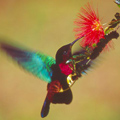 Chimney Swift Chaetura pelagicaCredit: Canadian Wildlife Service, Environment Canada(Size: 132.92 kb) |
Close parentage
Hummingbird fossils are inexistent. It is thus very difficult to date their appearance on Earth. However, DNA analysis has permitted the identification of genetic links between various hummingbird species and also with other birds. In light of these analyses, it seems that the hummingbird has the same ancestry as the swift, dating back some 35 million years. This is why trochilidae are part of the same order as swifts, the apodiform order, birds with pointed wings and very short feet.
 Purple-throated Carib Eulampis jugularisCredit: Jean Léveillé(Size: 32.83 kb) |
Evolution with flowers
Thousands of plant species depend solely on hummingbirds for pollination. In turn, hummingbirds are very heavily energy-dependent on flowers for their source of food throughout the year. The evolving relationship between hummingbirds and plants is a good example of mutualism, resulting in the multiple adaptations observed in flowers and hummingbirds. The most striking observation is the close relationship that exists between the shape and length of the hummingbird beak and the morphology of the flowers from which they feed. This evolutionary adaptation of the beak took place at the same time as the adaptation of flowers. Certain flowers evolved adapting to the shape of the beak of certain hummingbirds, and certain hummingbirds evolved adapting the shape of their beak to certain shapes of flowers.
|

